As I walked through my local appliance store, I felt guilty looking at the energy-wasting machines. With rising utility costs, I knew I had to act. I wanted to save money and help the planet. That’s when I learned about energy-efficient appliances and how they changed my view on home efficiency.
In this guide, we’ll dive into energy-efficient appliances. We’ll show you how to cut down on utility bills and help the environment. You’ll learn about energy ratings, smart features, and how to make smart choices for a greener lifestyle.
Key Takeaways
- Energy-efficient appliances can significantly reduce utility costs and promote environmental sustainability.
- ENERGY STAR certification and EnergyGuide labels provide valuable insights into an appliance’s energy efficiency.
- Smart features like temperature control and automation can further enhance energy savings.
- Upgrading to energy-efficient kitchen, laundry, and other household appliances can lead to long-term financial benefits.
- Proper maintenance and government incentives can help maximize the cost-saving potential of energy-efficient appliances.
Understanding Energy Efficiency Ratings and Labels
When you’re looking for new appliances, it’s key to know about energy ratings and labels. These help you pick the best options for saving money on your bills. They show how much energy an appliance uses.
ENERGY STAR Certification Explained
The ENERGY STAR label is well-known for energy efficiency. It means the appliance meets high energy standards set by the EPA. These products use 10-50% less energy than usual, which is good for the planet and your wallet.
EnergyGuide Labels: How to Read Them
The EnergyGuide label is also important. It tells you how much energy an appliance uses and its yearly cost. By comparing these labels, you can find the most energy-saving appliances.
Common Energy Rating Systems
- ENERGY STAR: Certifies that the appliance meets strict energy efficiency guidelines set by the EPA.
- EnergyGuide: Provides estimated annual operating costs and energy consumption data to help consumers compare appliances.
- SEER (Seasonal Energy Efficiency Ratio): Measures the cooling efficiency of air conditioners and heat pumps.
- HSPF (Heating Seasonal Performance Factor): Measures the heating efficiency of heat pumps.
- CEE (Consortium for Energy Efficiency) Tiers: Voluntary energy efficiency specifications that go beyond ENERGY STAR requirements.
Knowing about these ratings helps you choose better appliances. It’s a step towards using less energy and saving money.
| Rating System | Description | Key Appliances |
|---|---|---|
| ENERGY STAR | Certifies that the appliance meets strict energy efficiency guidelines set by the EPA. | Refrigerators, dishwashers, washing machines, air conditioners, and more. |
| EnergyGuide | Provides estimated annual operating costs and energy consumption data to help consumers compare appliances. | Most major household appliances. |
| SEER | Measures the cooling efficiency of air conditioners and heat pumps. | Central air conditioners and heat pumps. |
| HSPF | Measures the heating efficiency of heat pumps. | Heat pumps. |
| CEE Tiers | Voluntary energy efficiency specifications that go beyond ENERGY STAR requirements. | Refrigerators, washing machines, and other major appliances. |
The Financial Benefits of Upgrading to Energy-Efficient Appliances
Switching to energy-efficient appliances can lead to big cost savings and a good return on investment (ROI) in the long run. By replacing old, energy-wasting appliances with new, eco-friendly ones, you’ll see your energy bills and utility expenses drop.
A study by the U.S. Department of Energy found that homes with ENERGY STAR-certified appliances save about $350 a year on utility bills. This means thousands saved over the life of the appliances.
| Appliance Type | Average Annual Savings |
|---|---|
| Refrigerator | $100 |
| Washing Machine | $75 |
| Dishwasher | $40 |
| Clothes Dryer | $100 |
Also, energy-efficient appliances can boost your home’s value. Homebuyers look for energy-saving features. Having ENERGY STAR-certified appliances can increase your home’s market price by thousands.
“Upgrading to energy-efficient appliances is one of the smartest financial decisions a homeowner can make. The long-term savings and increased home value make it a win-win investment.”
By choosing energy-efficient appliances, you get to save on utility expenses and possibly see a higher return on investment when selling your home.
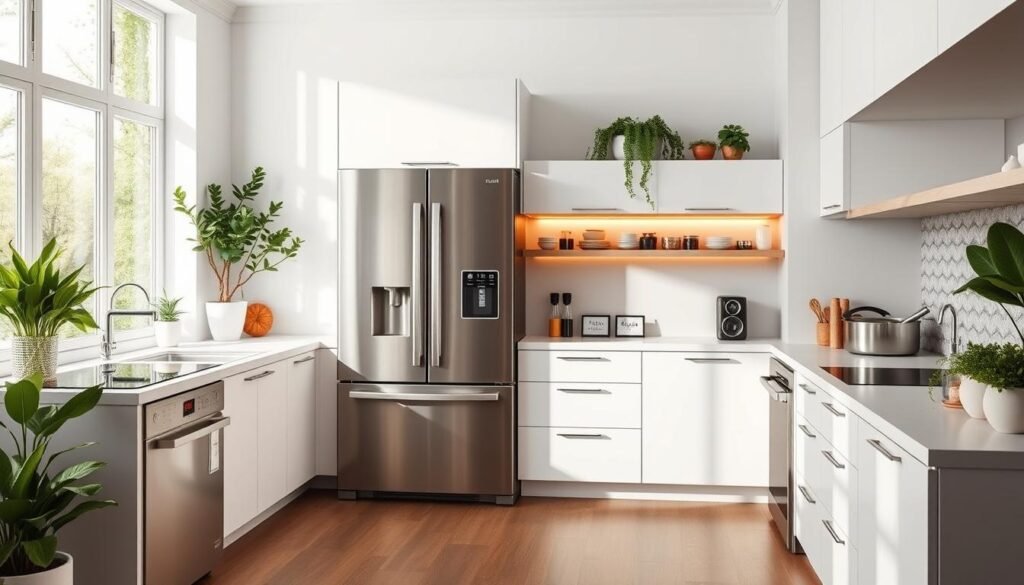
Smart Features That Maximize Energy Savings
Technology is changing how we use energy at home. Now, smart home appliances have features that save money and reduce carbon emissions. Let’s see how these smart features can cut down your energy costs.
Smart Thermostats and Temperature Control
Smart thermostats lead the way in saving energy at home. They adjust the temperature based on your habits and preferences. This ensures you’re comfortable while using less energy.
By linking with your smart home technology, these thermostats learn your routine. They then adjust the temperature to save energy, helping you save money.
Remote Monitoring and Usage Tracking
Many smart automated appliances let you track energy use from anywhere. This means you can see how much energy your appliances use and change their settings remotely. It gives you control over your home’s energy use.
With this data, you can make smart choices to use less energy. This helps you save money and reduce waste.
Scheduling and Automation Benefits
New smart home features include scheduling and automation tools. You can set your smart home technology to run big energy users like laundry or washing dishes when it’s cheaper. This way, you save money without changing your daily life.
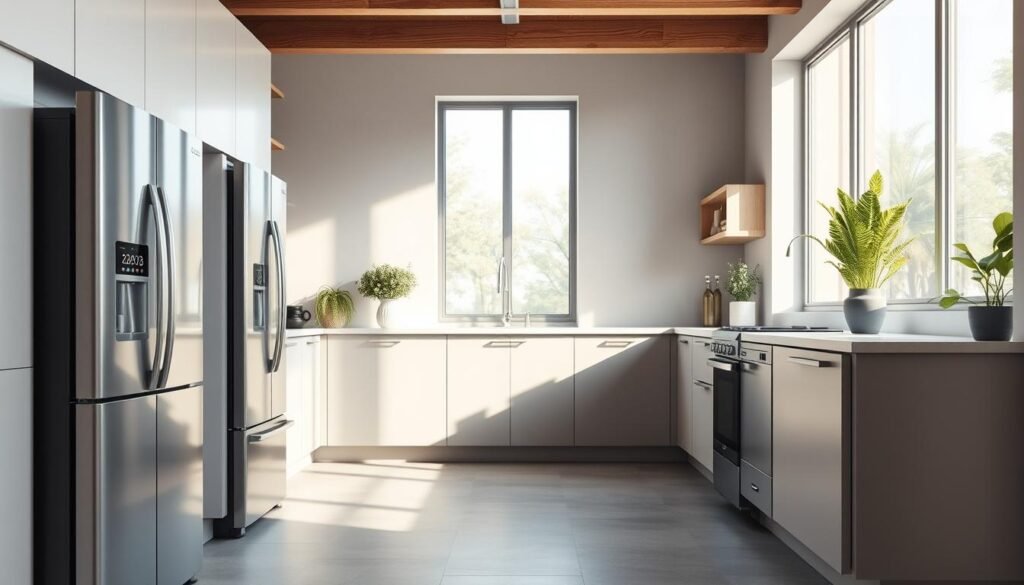
“Smart home features are revolutionizing the way we manage energy consumption, empowering homeowners to take control of their utility bills and reduce their environmental impact.”
Kitchen Appliances: Making the Smart Switch
Upgrading your kitchen? Start with energy-efficient appliances. Look for refrigerators, dishwashers, and ovens that save energy and money. These modern appliances cut down on energy use and utility bills.
When buying a new fridge, check for the ENERGY STAR® label. It means the fridge is very energy-efficient. Choose models with features like automatic door seals and advanced compressors. These help save energy without losing storage space.
Eco-friendly dishwashers also save water and energy. They have soil sensors and efficient wash cycles. These features clean your dishes well while saving resources.
Convection ovens are great for even cooking and saving energy. They use fans to circulate hot air. This cuts down cooking time and energy use.
“Upgrading to energy-efficient kitchen appliances is one of the best investments you can make for your home. The long-term savings on utility bills can be substantial.”
Switching to energy-efficient appliances makes your home greener and cheaper to run. Research well to find the right fit for your kitchen and budget.

Selecting the Right Energy-Efficient Appliances for Your Home
Choosing energy-efficient appliances for your home can seem hard. But, by looking at size, capacity, and long-term savings, you can pick the best ones. These choices will help your home use less energy and lower your bills.
Size and Capacity Considerations
First, figure out the right size and capacity for your home. A wrong choice can hurt efficiency and performance. Measure your space and think about your household size to find the perfect fit.
Cost vs. Long-term Savings Analysis
Energy-efficient appliances might cost more upfront. But, they save money on bills over time. Look at energy use, costs, and rebates to find the best deal for your budget and goals.
Installation Requirements
Check the installation needs for your new appliances before buying. Some might need special electrical or plumbing setups. Talk to a pro to make sure installation goes smoothly and doesn’t cost too much.
By keeping these points in mind, you can choose the best energy-efficient appliances for your home. This will save you money and help the planet in the long run.
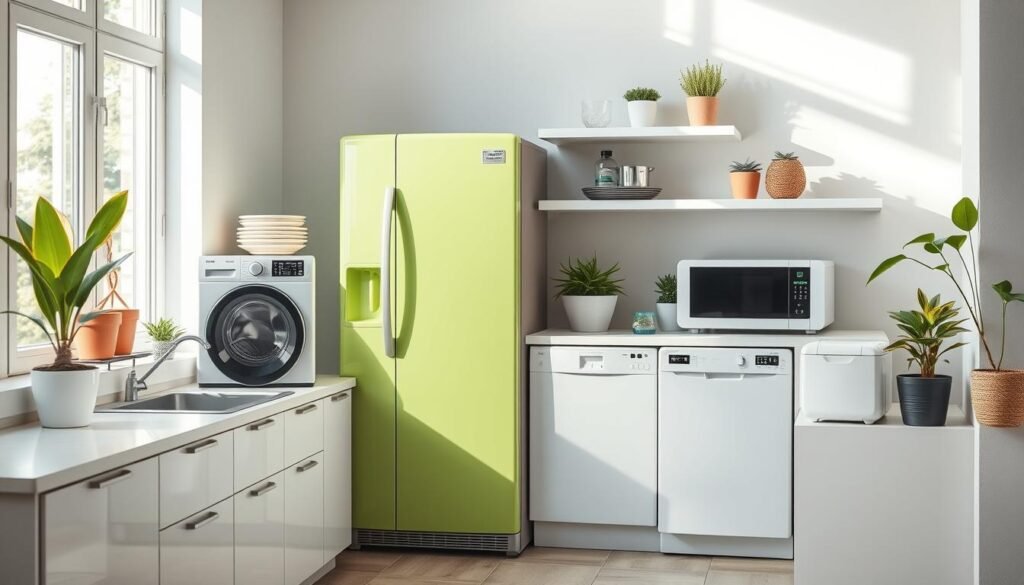
Laundry Room Updates: Washers and Dryers
The laundry room is a key area for saving energy in your home. Upgrading to energy-efficient washers and dryers can cut down on energy use and bills. Let’s look at the latest tech and features to make your laundry room more energy-smart.
Upgrade to Energy-Efficient Washing Machines
Today’s energy-efficient washers use less water and electricity without losing power. Look for the ENERGY STAR® label, which shows they meet high energy standards. These machines can save you up to 25% on energy costs compared to old models.
Embrace Eco-Friendly Dryers
New dryer tech also means big energy savings. Think about getting heat pump or ventless dryers, which use up to 50% less energy than traditional ones. These green choices cut down on carbon emissions and your monthly bills.
When picking out new laundry gear, focus on energy ratings and features for better laundry energy savings. The right picks can make your laundry routine cleaner, greener, and cheaper.
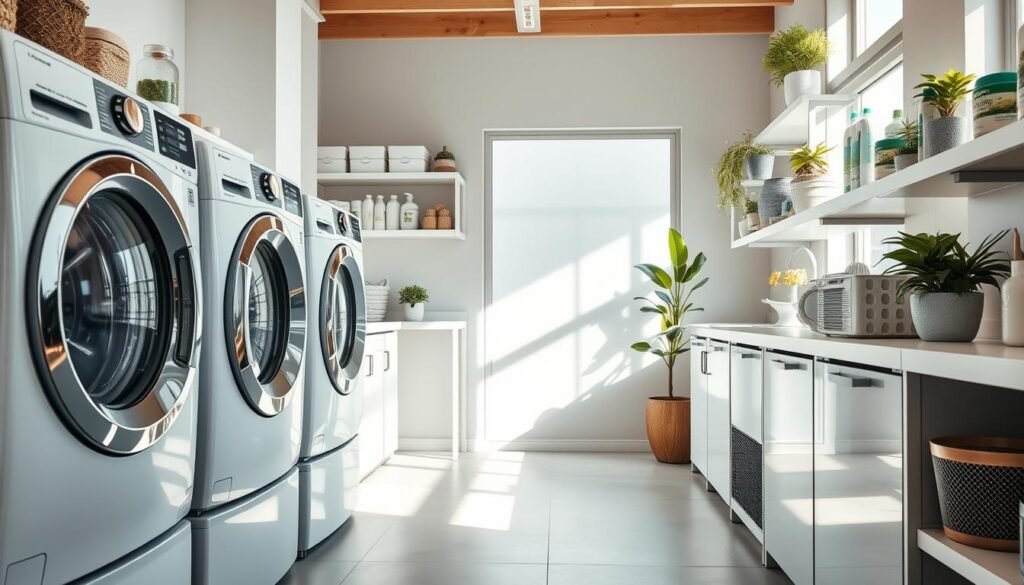
“Upgrading to energy-efficient laundry appliances is one of the easiest and most impactful ways to reduce your home’s energy consumption and lower your utility bills.”
Maintenance Tips to Maintain Energy Efficiency
It’s important to keep your energy-efficient appliances in good condition. Regular appliance maintenance and energy efficiency upkeep help your devices work better. This saves energy and money in the long run.
Regular Cleaning Schedules
Make a cleaning schedule for your appliances. This keeps them running efficiently. You might need to:
- Clean air filters in HVAC systems
- Wipe down refrigerator coils
- Clean dryer vents and lint traps
- Descaling coffee makers and other water-based appliances
Performance Monitoring
Keep an eye on how well your appliances are working. Look for:
- Changes in energy usage
- Unusual noises or vibrations
- Software or firmware updates
When to Replace Parts
Even the best appliances need part replacements sometimes. Watch for signs like:
- Less efficiency or performance
- More energy use
- Wear and tear on parts
By following these tips, your appliances will stay energy-efficient for a long time.
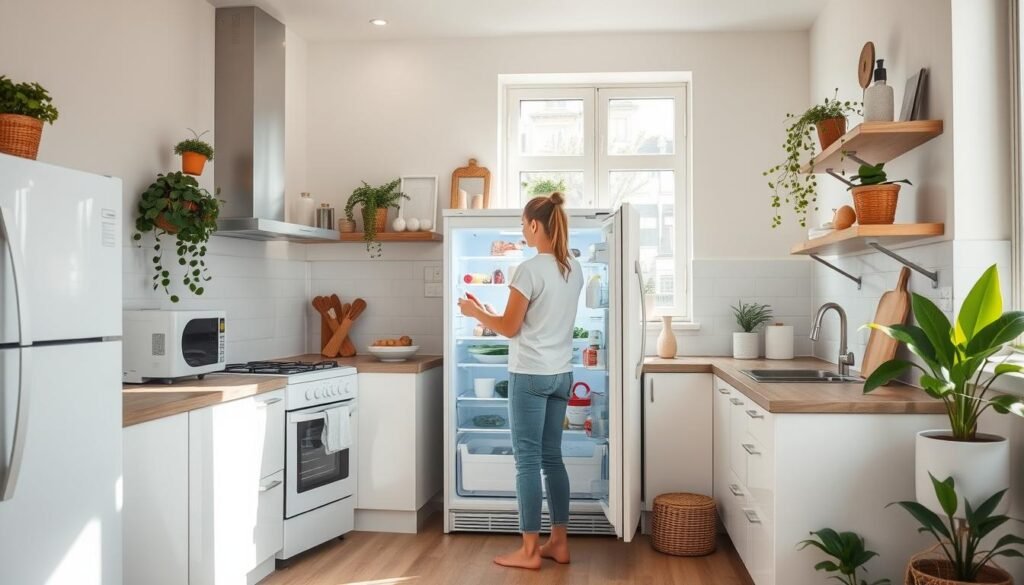
Government Rebates and Tax Incentives
Getting energy-efficient appliances can be pricey at first. But, many government programs offer rebates and tax credits to help. These incentives make it easier for homeowners to switch to eco-friendly appliances.
The ENERGY STAR program at the federal level gives tax credits for energy-efficient products. State and local governments also have their own rebate programs. These can add to the savings from federal incentives, making the cost of new appliances more affordable.
To use these government programs, you need to look into what’s available in your area. Check with your local utility company, state energy office, or the ENERGY STAR website. By using these incentives and the long-term energy savings, getting energy-efficient appliances becomes a smart and reachable choice.
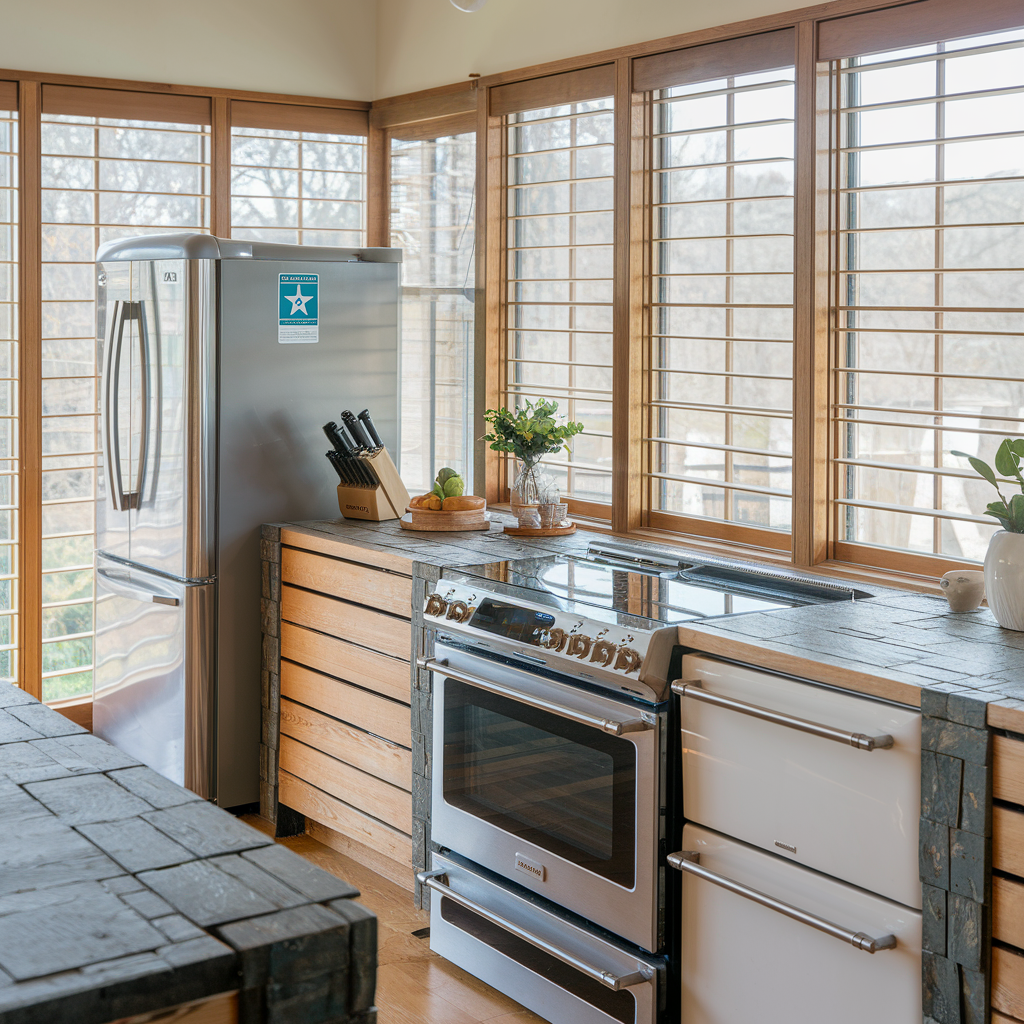

Hello, I’m Jane, founder of Home Vibe Ideas. I’m here to inspire stylish Home Design, modern Smart Living, beautiful Outdoor Spaces, and creative DIY Projects to help you create a home that’s uniquely yours.
Disclosure: This post contains affiliate links. If you click on a link and make a purchase, we may earn a small commission at no additional cost to you. The content on this site was created with the help of AI technology.


